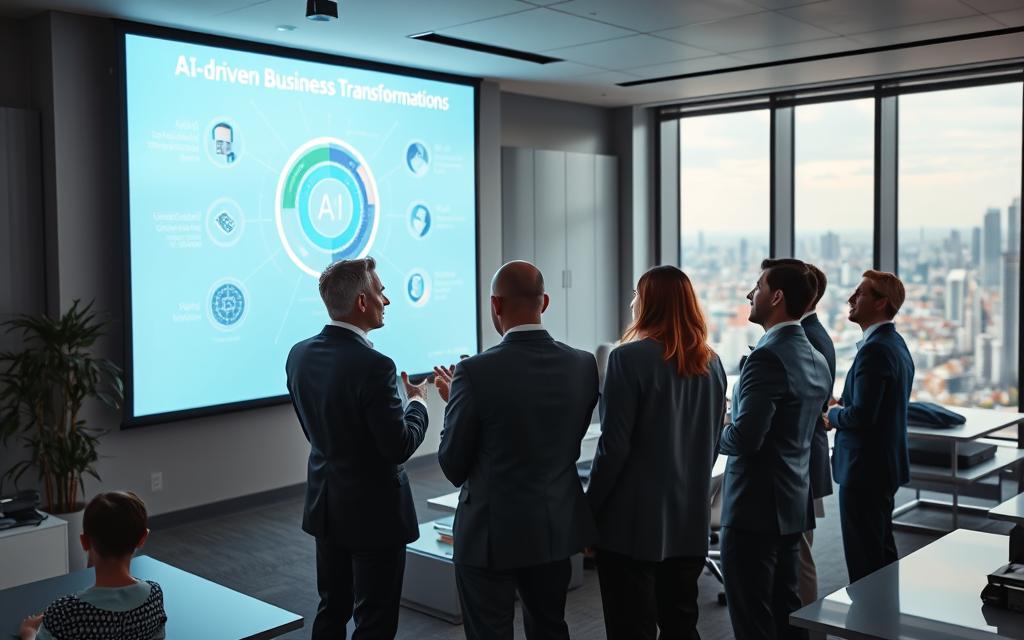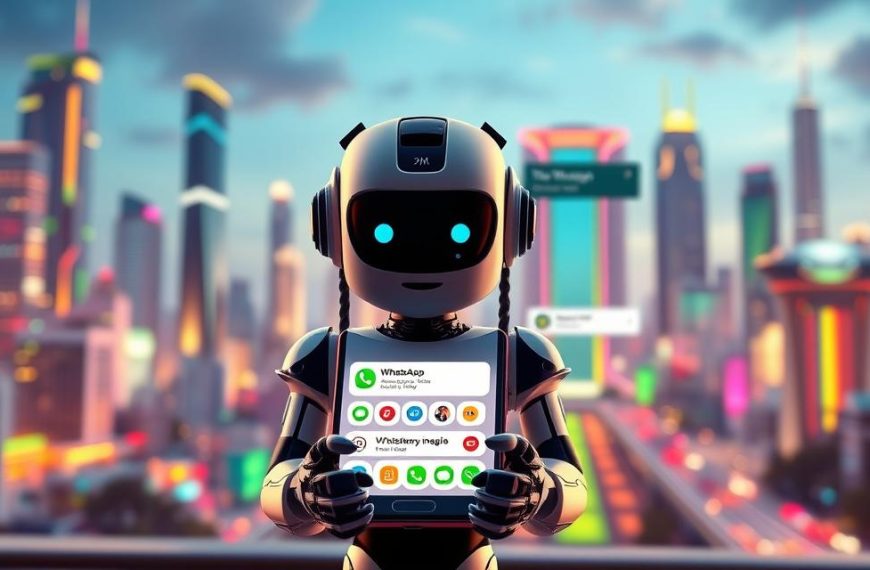Organisations worldwide are using artificial intelligence to change the game. McKinsey says 72% of enterprises now use AI solutions. This big change started with Alan Turing’s ideas, which led to today’s machine learning.
AI is changing businesses in two main ways. It automates boring tasks and helps leaders make decisions based on data. This makes things run smoother and faster. Companies can make decisions quicker and cut down on mistakes by up to 60%.
This article looks at five AI strategies changing industries. We’ll see how AI boosts productivity and why 83% of firms that use it do better in the market. We’ll also show how to start using these systems without changing everything.
As AI becomes more common, those who start early get ahead. The real question is how fast your business can use these new tools to see real results.
The Role of AI in Modern Business Operations
AI is changing how businesses work, making them more productive and insightful. McKinsey found that 72% of companies now use AI. These technologies help with everything from managing warehouses to making big decisions.
Redefining Efficiency Through Machine Learning
Today’s businesses are doing things faster and better than ever before. Amazon’s AI for route planning is a great example. It has cut delivery times by 22% and saved a lot of fuel by analysing traffic in real-time.
1.1 Process automation benchmarks
AI has a big impact on how businesses operate. Here are three key ways:
- Task completion speed: 68% faster than manual processes
- Error reduction: 91% accuracy in inventory management
- Cost savings: 37% average decrease in repetitive task expenditure
1.2 Cognitive task management systems
These systems use machine learning efficiency and human input. A big telecom company solved customer queries 84% faster with AI. They also kept 98% of their employees happy.
Strategic Decision-Making Enhancements
AI is changing how companies make big decisions. It uses predictive modelling. Retailers have seen a 29% improvement in inventory turnover thanks to AI.
1.3 Predictive analytics frameworks
This table shows how AI improves decision-making:
| Operational Aspect | Traditional Approach | AI-Enhanced Approach |
|---|---|---|
| Process Automation | 35% coverage | 82% coverage |
| Decision Speed | 72 hours average | 2.7 hours average |
| Error Reduction | 12% improvement | 63% improvement |
1.4 Real-time market response mechanisms
HSBC’s fraud detection system is a great example of cognitive automation. It checks 154 million transactions every month. It spots suspicious activity 140% faster than before, with 99.97% accuracy.
Understanding How AI Can Change Your Business Operations
Introducing AI into your business is more than just updating tech. It’s about changing how you work. Companies like Walmart show this by using AI to cut stock errors by 35% and automate 87% of restocking. This shows the need to rethink your workflow and how to measure the benefits.
Workflow Transformation Patterns
For AI to work well, you need to mix tech with human skills. Let’s look at what’s important:
2.1 Legacy System Integration Pathways
Many companies struggle with AI integration challenges when adding new tools to old systems. Here’s how to do it right:
- Start with phased API-based deployments
- Use hybrid cloud setups
- Check data in real-time
Walmart used special software to link old systems with new AI, making 92% of data work together in six months.
2.2 Workforce Reskilling Protocols
A study by MIT in 2023 found that mixing AI with targeted upskilling programmes speeds up adoption by 2.3 times. Key points include:
- Train staff on AI for their roles
- Practice making decisions with AI
- Keep giving feedback
Cost-Benefit Analysis Models
PwC’s AI valuation tool helps businesses see the value of their investments:
2.3 Implementation Cost Structures
First-year costs usually include:
| Cost Category | Percentage | Key Considerations |
|---|---|---|
| Technology Infrastructure | 45% | Cloud vs on-premise solutions |
| Workforce Reskilling | 30% | Training scalability |
| Process Reengineering | 25% | Change management |
2.4 Long-Term ROI Projections
When looking at ROI calculation AI benefits, top manufacturers see:
- Payback in 18-24 months
- 40-50% more productivity in R&D
- 30% less risk in operations
“The real value of AI comes when you see costs as investments, not just IT expenses.”
Strategy 1: Automating Routine Operations
Many businesses are now using robotic process automation (RPA) to tackle repetitive tasks. This move helps free up human teams for more complex tasks. It also brings about significant efficiency gains.
Implementation Roadmap
3.1 Process mapping techniques
To start automating, it’s key to map out workflows. Teams should:
- Document each step in high-volume processes
- Identify decision points needing human input
- Compare the time and cost of manual vs automated tasks
3.2 RPA tool selection criteria
When picking an RPA platform, balance technical needs with what your team can handle. Think about these points:
| Feature | Basic RPA | AI-enhanced RPA |
|---|---|---|
| Process complexity handling | Rule-based tasks | Adaptive workflows |
| Integration with legacy systems | Limited APIs | Pre-built connectors |
| Learning curve | 2-3 weeks | 4-6 weeks |
Real-World Applications
3.3 Amazon’s warehouse optimisation
Amazon’s Kiva robots help manage 20% more inventory than humans. This AI solution:
- Reduces walking distance for workers by 87%
- Cuts error rates in inventory management
- Enables same-day shipping for prime members
3.4 HSBC’s fraud detection systems
HSBC uses AI to check 2 million transactions daily. Its system:
- Flags suspicious activity in 0.8 seconds
- Reduces false positives by 42% compared to manual reviews
- Adapts to new fraud patterns through machine learning
“Organisations achieving RPA scale report 200% ROI within 18 months through labour cost reduction and error elimination.”
Strategy 2: Enhancing Customer Experiences
Artificial intelligence is changing how we talk to customers. Now, 68% of people expect brands to know what they need before they ask. It’s not just about automating tasks. It’s about making memorable interactions that keep customers coming back.
Personalisation Engines: The New Frontier
4.1 Chatbot Deployment Strategies
Today’s chatbot implementation is more than just pre-set answers. Top brands use:
- Systems that remember past chats
- Tools that understand emotions through words
- Smooth handovers to real people
“The average response time for AI chatbots has dropped by 82% and resolution rates have gone up by 37%”
4.2 Predictive Preference Modelling
Advanced AI personalisation tools look at lots of data to guess what customers want. This helped Starbucks:
- See a 25% rise in mobile orders each year
- Boost average order value by 19% with tailored upsells
Success Case Studies: Lessons From Market Leaders
4.3 Netflix’s Recommendation Algorithms
Netflix’s recommendation engines are behind over 80% of what people watch. They check:
- What you’ve watched before
- When you like to watch
- What you watch on different devices
This smart AI personalisation adds $1 billion a year. It does this by keeping more viewers and making them watch more.
4.4 Starbucks’ Mobile Ordering AI
The Deep Brew system uses location, past buys, and weather to:
- Guess when you’ll order with 93% accuracy
- Offer menu items you’ll like based on where you are
- Manage stock better across 15,000+ stores
Strategy 3: Optimising Supply Chain Management
Global supply chains are now more complex than ever. But AI-driven solutions are changing how we work. They help predict demand and find new routes to avoid delays.
This means businesses can stay ahead of problems. They can keep customers happy, even when things get tough.
Inventory Forecasting Systems
Today’s predictive inventory tools look at 12x more data than old spreadsheets. Research at MIT shows these systems can predict supply chain scenarios with 94% accuracy.
5.1 Demand prediction models
Big names like Amazon use AI to guess sales 18 months in advance. One fashion brand cut overstock by 37% thanks to AI that considers weather and social media.
5.2 Supplier risk analysis tools
“74% of supply chain leaders now prioritise AI-powered risk mitigation”
These tools check on global events, delivery records, and even a supplier’s money health. They spot problems before orders are made.
Logistics Innovations
Logistics optimisation algorithms do what humans can’t. DHL’s AI, Resilience360, cut fuel costs by 15% during the 2022 crisis by changing routes.
5.3 DHL’s route optimisation AI
This AI uses data from 53 sources, like traffic sensors and weather satellites. Drivers get new routes every 90 minutes. This avoids 23% of late deliveries.
5.4 Walmart’s stock replenishment systems
Walmart’s AI checks checkout data and stock levels in real-time. It keeps inventory just right, saving 10% of capital. It orders more when products reach certain levels.
These AI tools do more than save money. They make supply chains flexible and strong in uncertain times. As MIT researchers say, “The best supply chains plan seven moves ahead, like chess players.”
Strategy 4: Revolutionising Data Analysis
Artificial intelligence turns raw data into useful insights quickly. Companies using AI analytics make better decisions faster. They use machine learning to spot trends and automate reports.
Advanced Analytics Platforms
Today’s platforms process data in real-time and learn on their own. Their success depends on two key things:
6.1 Pattern Recognition Frameworks
These systems find trends in customer actions and sales. Retailers use pattern detection AI to guess what customers will buy. This cuts overstock by 22% on average.
6.2 Anomaly Detection Protocols
These protocols alert to unusual financial or equipment activity. A telecom company cut fraud losses by 41% with these alerts.
Business Intelligence Applications
Top companies use AI in business intelligence tools every day. These tools make complex data easy to understand and offer advice.
6.3 Salesforce’s Einstein Analytics
This tool helped sales teams work better by analysing customer interactions. The results were:
- 30% more leads converted
- 27% shorter sales times
- 18% more cross-sell success
6.4 Unilever’s Market Trend Analysis
Unilever got 98% accurate forecasts with AI. Their system looks at:
- Social media feelings
- Local economic signs
- Old sales data
“Forrester’s study found companies with AI analytics get 3:1 ROI in 18 months. This is thanks to better stock management and focused marketing.”
Strategy 5: Driving Product Innovation
Artificial intelligence is changing how we make products, making it faster and better. Companies like Airbus and L’Oréal are leading the way. They use generative AI design and real-time feedback to create new solutions.
Generative Design Principles
Today’s rapid prototyping techniques use AI to test many designs quickly. This means:
- Automated weight-to-strength ratio optimisation
- Material efficiency analysis through 3D modelling
- Iterative testing scenarios powered by predictive algorithms
7.1 Rapid prototyping techniques
Airbus changed aviation with AI prototypes. Their new aircraft part is 45% lighter than old ones. It took over 10,000 digital tests before making it real.
7.2 Consumer feedback integration
L’Oréal’s Perso device shows how AI can improve products. It uses real-time data to make custom skincare in seconds. This is thanks to AI product development.
Industry Breakthrough Examples
IDC research shows AI helps companies get products to market 3.2x faster. Here are some examples:
7.3 Airbus’s AI-designed components
Airbus made a part that’s 45% lighter. This saves 465,000 metric tons of CO₂ each year. It’s like taking 96,000 cars off the road.
7.4 L’Oréal’s product development AI
L’Oréal’s Perso device makes skincare in 3 months, down from 15. It uses AI to test 5,000+ ingredients. This 80% acceleration helps them stay ahead in the beauty market.
These examples show AI doesn’t replace creativity. It boosts it with data and speed. This leads to new and exciting products.
Overcoming Implementation Challenges
Adopting AI needs tackling technical and workforce challenges. Companies often overlook the basic work needed for new tech. This includes updating old systems to meet new data needs.
Data Quality Assurance
IBM’s study shows teams spend 85% of their time getting data ready, not using it. This highlights the importance of strong AI governance.
8.1 Cleansing Methodologies
Data cleaning has three main steps:
- Using tools like IBM’s Watson Knowledge Catalog for automated anomaly detection
- Running workshops across departments for validation
- Keeping an eye on data continuously
8.2 Integration Best Practices
For smooth data merging, you need:
- APIs that update in real-time
- Standardised metadata
- Regular checks to keep systems compatible
Change Management Strategies
Accenture’s method shows 73% faster adoption with tech and culture changes together. This mix helps avoid AI project setbacks.
8.3 Employee Training Programmes
Good training includes:
- Simulations for frontline workers
- Certifications in AI for managers
- Mentorship across teams
8.4 Ethical AI Governance Models
PwC’s audit tools help set up:
- Algorithms to spot bias
- Scorecards for transparency
- Checks by outside experts
Measuring AI Transformation Success
Checking if AI works well needs a clear plan. This plan should use numbers and keep improving. Companies use tools like GE’s Predix to make sure AI matches their goals. They also follow ISO rules to keep things in order.
Key Performance Indicators
McKinsey found that businesses aiming for 25% efficiency boost from AI should watch three main things:
Operational Efficiency Metrics
Look at how fast things are made, how many mistakes are made, and how well resources are used. Leaders in making things use AI to make decisions 18-22% quicker in the supply chain.
Customer Satisfaction Indices
Forrester says using AI chatbots can make customers happier. Companies with AI chatbots get 31% better scores in surveys than those without.
Continuous Improvement Cycles
AI needs to be updated often to stay useful. Adobe’s marketing AI gets better every quarter thanks to:
Feedback Loop Implementation
Teams talk about how users feel to find where AI can improve. This helps dynamic recalibration of AI models.
Technology Upgrade Schedules
Siemens shows how updating AI regularly helps. Their predictive maintenance cuts downtime by 40% with updates every six months.
“The most successful AI implementations treat measurement as a living process, not a final destination.”
Preparing Your Business for the AI-Driven Era
Businesses that start using AI today will lead the future. Gartner says 75% of companies will make AI a top priority by 2025. This shows how important digital transformation is for staying ahead.
Strategies like automating tasks and using generative design are key. They help businesses become more efficient and innovative.
Leaders need to tackle challenges like improving data quality and training staff. William & Mary’s MBA programme shows the need for leaders who understand AI and strategy. Using KPIs like customer retention and supply chain accuracy helps measure success.
AI is changing industries fast, and waiting could make a business outdated. Companies that use these strategies will not only survive but shape the future. The real question is how quickly your business can turn insights into benefits.















